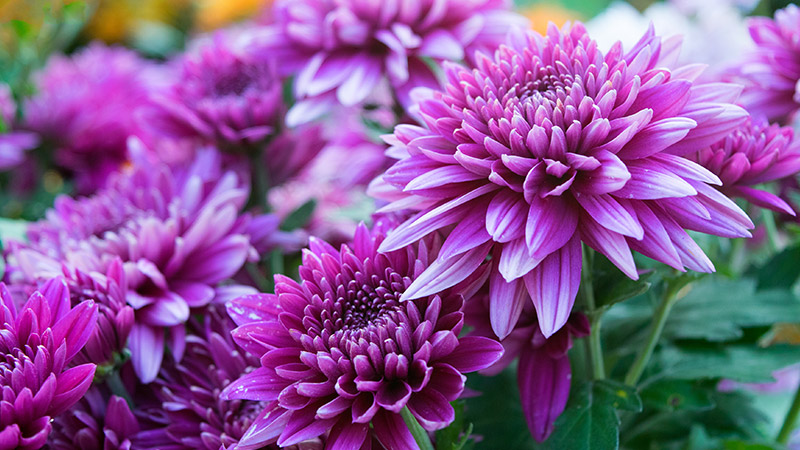Do Grapeberry Purple Mum Bloom Over and Over Again
Tips & Techniques
Betterdays in Full Swing

Chrysanthemums: The Ultimate Guide to Growing Beautiful Mums
Gardening

Information technology seems as soon as the air cools, signaling the coming of fall, garden centers begin showcasing full mounds of brilliant red, yellow, and violet flowers. Chrysanthemums, or mums, are a staple in autumn gardens. Mums are a national symbol of fall abundance, and this herbaceous and hardy perennial is an easy addition to requite a gorgeous pop of color in your fall garden mural. With a footling understanding and a few simple tips, you lot can take a lush, beautiful autumn chrysanthemum garden brandish to help celebrate the changing of seasons.
- What are Chrysanthemum?
- Types of Chrysanthemum
- Steps to Planting Chrysanthemums
- Caring for Chrysanthemums
- Chrysanthemum FAQs
What Are Chrysanthemum?
Chrysanthemum are a member of the Compositae family and are available in a wide range of brilliant colors, shapes and sizes. First cultivated in People's republic of china over 6 centuries ago, this type of daisy was initially grown as an herb associated with the power of life. The chrysanthemum flowers range from dazzling whites to deep bronzes, and the hardy plants are highlighted with full, dark greenish leaves.
Chrysanthemum flowers expect like they have a multitude of petals, but each private petal is actually a modest floret. There are two different types of florets: ray and disc florets. Ray florets are what we traditionally see as the petals, while the disc florets create the center buttons. When the florets are all clustered together, they give the states what nosotros know and love equally a mum bloom.

Types of Chrysanthemum
With over 100 different chrysanthemum cultivars in the U.s.a., the National Chrysanthemum Society has a classification system in place to categorize 13 different mums by flower shape.
- Anemone
These daisy-like blooms feature long, tubular florets clustered effectually a tight button center. They form a 4-inch bloom in unmarried or multiple colors.
Popular varieties include: Dorothy Mechum, Regal Light and Angel - Decorative
Florists apply decorative class mums in floral arrangements. The 5-inch plus blooms have a apartment appearance every bit the florets gradually become longer from the centre out.
Popular varieties include: Fireflash, Coral Charm and Honeyglow - Irregular Incurve
Incurve blooms feature florets curving inward. Irregular incurve mums feature big blooms between half dozen to 8 inches. The florets curve in and comprehend the center of the flower. A few florets at the bottom of the bloom add fringe to the stem.
Popular varieties include: Luxor, Blushing Bride and River Metropolis - Intermediate Incurve
The florets of an intermediate incurve mum don't embrace the centre of the bloom. With shorter florets curving inwards, the less-compact bloom of an intermediate incurve only reaches a maximum 6 inches.
Popular varieties include: Apricot Alexis, Aboveboard and Pat Lawson - Regular Incurve
Regular incurve chrysanthemum blossoms are tight, shine globes of inwardly curving florets. Each blossom is betwixt 4 to 6 inches in diameter.
Popular varieties include: Gillette, Moira and Heather James - Pompom
Resembling the regular incurve, Pompom mums are just one to four inches. The tight blooms are common in floral arrangements.
Popular varieties include: Rocky, Yoko Ono and Lavander Pixie - Quilled
Bear witness-stopping quilled chrysanthemums characteristic long, tubular florets that open up to a spoon shape or slight downwards bend at the end. Their spiky appearance often mimics other types of mums.
Popular varieties include: Seatons Toffee, Mammoth Xanthous Quill and Muted Sunshine - Unmarried and Semi-Double
These daisy expect-a-likes feature 1 or two rounds of ray florets effectually a compact center. Their total constitute size is betwixt 1 to 3 anxiety, making them ideal for minor spaces and borders.
Pop varieties include: Rage, Icy Island and Reddish Glory - Spider
Spider mums are well known for their long, spiky florets of single or multiple colors. The tubular florets resemble spider legs and can go in all directions. The frail and exotic appearance creates a focal bloom in your garden.
Popular varieties include: Evening Glow, Symphony and Western Voodoo - Spoon
Spoon mums have a button centre surrounded past ray florets featuring a spoon shape at each tip. They are oft mistaken for single chrysanthemums, merely the difference lays in the slight bend.
Popular varieties include: Kimie, Fantasy and Redwing - Reflex
The flower of a reflex mum is slightly apartment with florets that curve downward. The crossing of the florets produces an interesting feather-similar appearance.
Popular varieties include: White City, Champion and Apricot - Thistle
The thistle bloom, also called the bush-league bloom, oft features multi-colored blooms. The long, sparse florets twist to rise up or fall backwards towards the stalk. Thistle blooms have a unique, exotic expect to them.
Pop varieties include: Cindy, Cisco and Orange Spray - Unclassified
With and then many chrysanthemum varieties, many chrysanthemum blooms feature characteristics that identify them in more than than ane category. Unclassified mums exhibit a broad range of colors and sizes.
Popular varieties include: Lone Star, Lili Gallon and Pacificum
Steps to Planting Chrysanthemums
You may be asking yourself how to grow chrysanthemums to fill your garden landscape as apace equally possible. Taking the time to first empathize how to constitute chrysanthemums rewards you with full, cute plants loaded with blooms.
- When to Plant Chrysanthemums?
Planting chrysanthemum in the spring gives the perennial plant time to establish and adjust to its new garden home. Yous'll easily discover mums in garden centers and nurseries in both fall and spring, only planning ahead is cardinal to successful planting. It's tempting to buy those huge cute autumn mums you see during the autumn flavour, but in terms of longevity, the smaller spring mums are actually a improve investment.The root organization becomes stronger throughout the summer and autumn, which increases a plant'southward ability to survive the winter. Planting in the spring will as well effect in a bigger flower the following flavor. Although some autumn mums can survive winter if planted immediately, the odds are much better with leap-planted mums. - How Hardy Are Chrysanthemums?
The chrysanthemums you lot purchase in garden centers are frequently referred to as "hardy mums" for a reason. The majority of mum varieties are wintertime hardy in Zones v through nine. Some varieties, such equally Mammoth Daisy, are hardy down to Zone three.When shopping for mums, check the characterization to make certain you're purchasing hardy garden varieties appropriate for your planting zone. Local nurseries and garden centers will well-nigh oftentimes feature the varieties that are specific to local areas. Avoid purchasing from floral shops – their mums are different, less hardy floral varieties. - What is the Best Soil for Mums?
Chrysanthemums can survive in almost soils, only they thrive in well-draining soil with consequent moisture. Growing mums in hard, dry soil prevents the roots from condign well established, while moisture, boggy soil drowns the roots. Finding the centre ground is key.If you've planted other perennials, then yous already know how to constitute chrysanthemum. To create a skillful soil for your mums, work your soil to a depth of 8 to 12 inches. Mix in 2 to 4 inches of organic material, such as compost or peat moss. The perfect soil texture tin can be tested past taking a handful and squeezing. When y'all open your hand, the soil shouldn't clump or rapidly fall apart. It should simply crumble. - How Much Sunlight Do Mums Crave?
Chrysanthemums are sun-loving plants. Although they technically crave only half-dozen hours of sunlight each twenty-four hour period, the more light they receive, the better their growth, blossom and hardiness. Slight shade in hot, summertime afternoons is appropriate in warmer gardening zones to prevent scorching.Mums bloom due to their photoperiodic nature. When the plant senses a alter in the length of darkness in late summer, it begins to fix buds. Planting about artificial lights, such as security lights or porch lights, tin change the bloom fourth dimension of your mums. - Does Spacing Actually Matter?
It can be tempting to plant mums closely together. Smaller, spring mums don't seem to fill up out a garden space as well. However, proceed in mind that by fall, most properly planted mums will reach up to three feet in height and width. Like many perennials, mums will often get larger each year. Even if your bloom bed looks a scrap bare when y'all starting time constitute your mums, in fourth dimension it will fill in.Spacing mums properly is essential for plant wellness. Plants that are too crowded compete for nutrients, accept root arrangement issues, attract pests and suffer from disease. Post-obit the plant spacing directions for your chrysanthemum variety increases the health of your garden and protects your investment of fourth dimension and coin.
Caring for Chrysanthemums
Mums are more often than not considered low maintenance plants. Knowing how to care for chrysanthemums properly simply requires basic gardening techniques. With just a little special chrysanthemum care, your garden volition be filled with a multitude of cute blooms.
- How Ofttimes Should Mums Be Watered?
Mums crave fifty-fifty moisture for the all-time growth. Consistent watering throughout the spring, summer and fall is essential. Once the footing is frozen in the winter, watering can be suspended until spring warms the soil.Early morning watering, to a depth of 6 to 8 inches, is recommended. The ideal watering method for mums is one that applies moisture straight to the base of the plants. This prevents wet from becoming trapped in the thick foliage. Soaker hoses can provide even, consistent moisture straight to the basis, and a water timer saves y'all the hassle of having to recollect to manually h2o. - Should Chrysanthemums Be Pruned?
Don't worry near how to clip chrysanthemums. Mums aren't exactly "pruned," merely are instead pinched throughout the growing flavour. This helps the plant branch out, become fuller and offer more blooms. When your plant reaches six inches tall in the spring, just pinch off i inch of each shoot. Echo this every 2 to 3 weeks until early on summer.Deadhead spent blooms throughout the fall for an extended bloom fourth dimension. Once the found has died in the winter, resist cutting it back. Research reveals that allowing information technology to die dorsum naturally over the winter produces a stronger found. Simply clean up the dead stems and foliage in the spring. - Is Fertilizer Necessary for Mums?
All plants require nutrients. Fertilizing your mums gives them an added boost of essential nutrients for the best growth. The master growth of chrysanthemum institute varieties takes place in bound and early on summer. Growing chrysanthemums are heavy feeders. Consistent applications of quality fertilizers will assist your mums abound larger and produce more than blooms.Choose a balanced, water-soluble fertilizer for monthly application from early spring through July. If you plant fall mums, await to begin their fertilization until the spring. Autumn fertilization can actually reduce the hardiness of chrysanthemums to survive cold winters. - How Can Y'all Increase Winter Hardiness?
The key to winter survival is a consistent soil temperature. Frequent freezing and thawing cycles impairment the roots and confuse the plant. Adding a thick layer of mulch – upwardly to 4 inches – can help maintain an even soil temperature throughout winter.Spread mulch under your mums as shortly every bit the surface of your soil begins to harden and the thermostat begins to dip into the 20s. Using a loose mulch, similar straw, can reduce compaction and increase the insulation of the footing. - Can Chrysanthemums Be Divided?
Similar many other perennials, chrysanthemum benefit from dividing every 3 to iv years. You may notice your mums begin to expect sparse in the centers and oddly shaped. Over time, the centre roots of the plant may get old and woody, while the outside roots are younger and healthier. If y'all observe your mums no longer grow full and round, they may simply demand to be divided.Spring is the best fourth dimension to divide your mums. Gently remove the plant from the footing and pause it upwardly into smaller sections. You tin can discard the woody center of the institute, since it won't perform also as the younger, outer sections. Replant in garden soil rich with organic matter.
Chrysanthemum FAQs
Can You Abound Chrysanthemum from Seeds?
Although most mums are purchased from garden centers equally already-established plants or propagated from cuttings and partitioning, you tin grow chrysanthemums from seed. It tin be a scrap of an take chances, considering many chrysanthemum seeds do not stay truthful to the parent plant. This ways you can finish upwards with a wide variety of bloom colors and sizes.
Mums take a long growing season. Growing chrysanthemums from seeds requires planning in areas with short growing seasons. Showtime the seeds indoors half dozen to eight weeks prior to the last frost appointment. Transfer to the garden when the chrysanthemum seedlings are half dozen to viii inches tall. Expect to encounter blooms the start year after planting.
Can Y'all Grow Chrysanthemum in Pots?
Growing chrysanthemums in pots is a perfect garden solution for apartments and small gardens. Near garden mums grow to 2 to 3 feet in size and crave at least a 12-inch container for the all-time support. Rich potting soil with good drainage is essential.
To encourage root growth, water container mums from the bottom of the container. Add a water-soluble fertilizer on a weekly basis. Because mums require the proper sunlight to fix blooms, placing your plant in a south-facing window and away from bogus light produces the best results. Storing in a protected garage during the winter months can help your plant remainder for new bound growth.
How Long Does It Take for Mums to Grow?
The chrysanthemum growing rate depends on many variables. Different varieties characteristic different growth rates and mature size. Plants grown from seed may take several years to accomplish their full growth potential. Mums grown from already-established garden center plants and segmentation take a caput-start on the growing season. Taking proper care of mums through watering, fertilizing and pinching increases the fullness and growth capabilities of the institute.
How Long Do Mums Last Later on They Flower?
Although we generally think of fall as being chrysanthemum season, there are actually three different types of blooming mums: early bloomers, early on fall bloomers and late fall bloomers. Early bloomers ofttimes begin flowering in late July, early fall bloomers testify off blooms in September and late autumn bloomers start their stunning display of colors in Oct. Each diversity differs, but most mums volition proceed to flower for 4 to eight weeks.
In that location are many means to extend the flowering of chrysanthemums. Deadheading spent blooms, fertilizing in the spring and avoiding overcrowding will assistance your mums produce more blooms over a longer menstruum of time.

Durable, Flexible Hoses The source of happiness, non hassles.
Our Hoses

Spray Nozzles To fit the need, and your grip.
Our Nozzles

Adjustable Sprinklers Water your lawn, not the sidewalk.
Our Sprinklers
Source: https://gilmour.com/growing-chrysanthemum
0 Response to "Do Grapeberry Purple Mum Bloom Over and Over Again"
Post a Comment